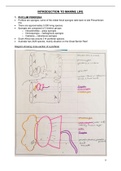6.
Provide 5 characteristics of the phylum Cnidaria. (5 marks)
Answer: 1. They are bell-shaped/tubular animals
2. Their body has layers:
- Outer protective epidermis
- Mesoglea
- Gastrodermis
- Inner endoderm layer – secretes juices and enzymes directly into gastrovascular
cavity (GVC).
3. They possess radial symmetry
4. Their mouth is surrounded by tentacles connected to GVC.
5. They have no circulatory, respiratory, or excretory organs.
6. Reproduction has two phases = sexual budding (polyps) and sexual reproduction
(medusa).
7. All are aquatic – mostly marine species.
8. They have 2 basic body forms during their life cycle:
- Polyps – mouth directed upwards, tubular/flower-like, sessile.
- Medusa – mouth directed downwards, jellyfish/umbrella shape, mobile.
9. Muscle fibres & nerve fibres can contract and expand which results in directional
movement.
10. Polyps are sessile (stay in one place) = e.g. sea anemones
11. Medusas are mobile (float or swim in a water column) = e.g. jellyfish
12. Tentacles form a ring around the mouth & can reach out and grasp prey that has been stung by cnidocytes.
13. Gaseous exchange occurs directly across the body surface.
14. Waste is released either through gastrovascular cavity (GVC) or through the skin.




